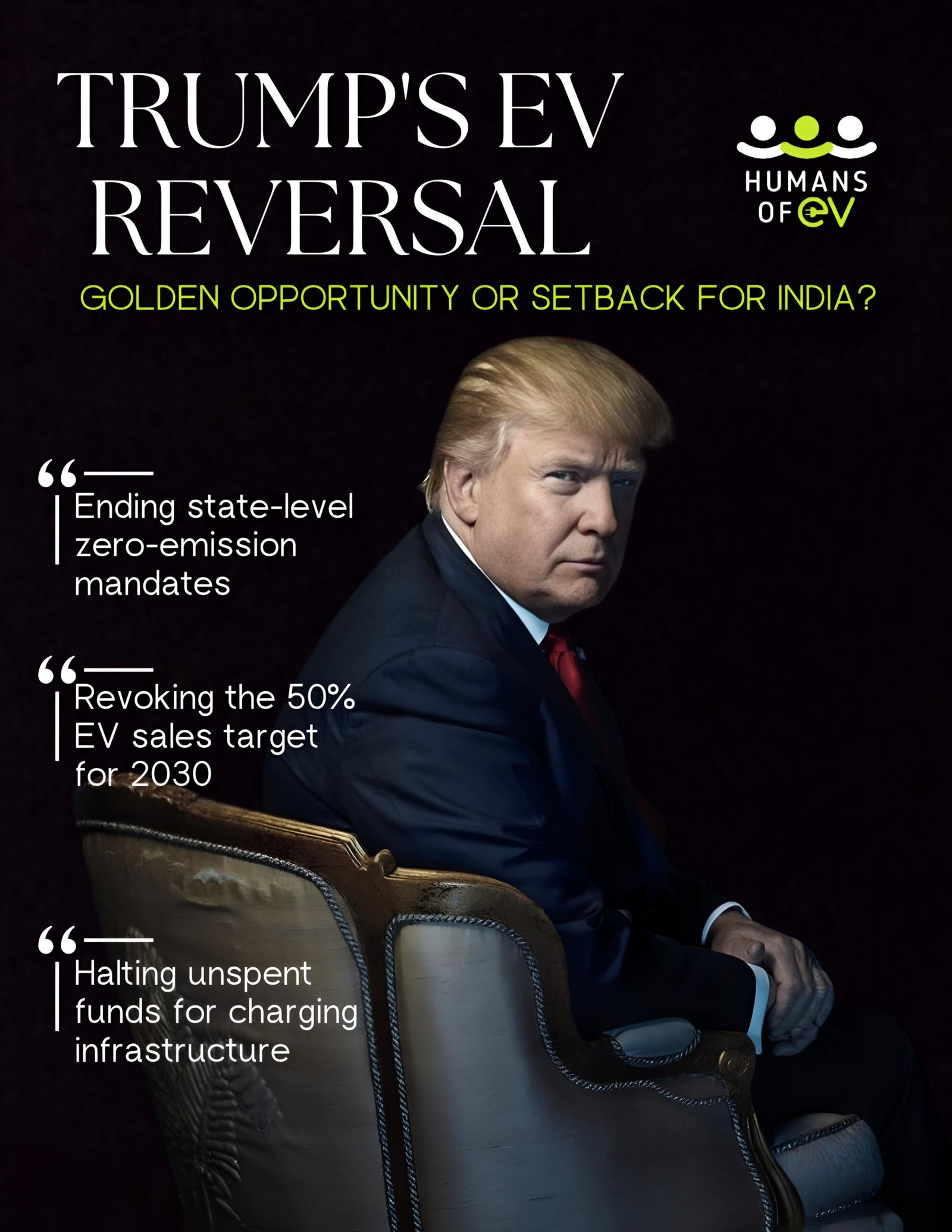
January 22nd, 2025
President Donald Trump’s recent executive orders reversing major EV policies in the United States have sent ripples across the global EV ecosystem. For India, one of the fastest-growing EV markets, these changes present a mix of opportunities and challenges. With projections of India’s EV market surging from 1.7 million units in 2023-24 to 10 million units by 2033, understanding these shifts is critical for policymakers and industry leaders.
The U.S. Policy Reversal
On January 20, 2025, President Trump signed executive orders undoing pivotal EV initiatives:
- Revocation of the 50% EV sales target for 2030: This ambitious goal, set by the Biden administration, served as a benchmark for U.S. EV adoption.
- Halting unspent charging infrastructure funds: Over $5 billion allocated under the Bipartisan Infrastructure Law is now on hold.
- State-level zero-emission mandates canceled: California and other states with strict emission standards face policy rollbacks.
- Federal EV tax credits under review: The potential elimination of the $7,500 tax credit could dampen U.S. EV sales.
Collectively, these actions signal a slowdown in the U.S.’s EV transition, altering global investment and production dynamics.
Opportunities for India
1. Global Market Expansion
- The U.S. accounted for 10% of global EV sales in 2024. A production slowdown in the U.S. creates opportunities for Indian EV manufacturers to expand their presence, particularly in emerging markets like Southeast Asia and Africa.
- India’s EV sales are forecasted to grow rapidly, with 25% penetration in two-wheelers by 2030.
2. Technology Partnerships
- U.S.-based EV firms, facing reduced domestic policy support, may seek cost-effective partnerships with Indian companies.
- India’s 28% growth in EV component exports in 2024 underscores its growing importance in global supply chains.
3. Investment Redirection
- Global EV investments hit $127 billion in 2024, with India attracting $1.5 billion in FDI. As investor confidence wanes in the U.S., India’s stable policies like FAME II and PLI schemes could draw increased capital.
Challenges for India
1. Supply Chain Disruptions
- The U.S. accounted for 18% of global EV battery demand in 2024. A reduction in demand could disrupt economies of scale, increasing costs for India, which imports 70% of its lithium-ion batteries.
2. Innovation Slowdown
- The U.S. contributed over 35% of global EV patents in 2024. Reduced R&D spending could limit access to cutting-edge technologies for India’s EV industry.
3. Investor Uncertainty
- Policy instability in the U.S., the world’s second-largest auto market, may make global investors cautious, potentially affecting emerging EV markets like India.
India’s Position in the Global EV Market
India’s EV market remains resilient, backed by strong government initiatives:
- FAME II: ₹10,000 crore allocated to subsidize electric two- and three-wheelers, reducing upfront costs.
- PLI Scheme: ₹18,100 crore focused on advanced battery manufacturing and EV components.
- GST Reduction: EVs taxed at 5%, with tax benefits of up to ₹1.5 lakh on loans for EV purchases.
- Growth Projections: India’s EV penetration in two-wheelers is expected to rise from 5% in 2024 to 25% by 2030.
Strategic Considerations for India
1. Strengthening Manufacturing
- Expand Domestic Production: Focus on high-demand segments like two- and three-wheelers, which account for 80% of India’s EV sales.
- Invest in Local Battery Production: Build robust supply chains to reduce dependency on imports.
2. Enhancing R&D Capabilities
- Allocate more resources to R&D for battery efficiency and lightweight materials.
- Partner with global firms to establish EV research hubs in India.
3. Leveraging Global Shifts
- Position India as a reliable alternative for EV manufacturing and supply chain management.
- Target partnerships in Europe, Southeast Asia, and Africa, where EV adoption is still growing.
Conclusion
The reversal of EV policies in the U.S. presents both opportunities and challenges for India’s EV sector. While India can capitalize on global shifts by attracting investments and forming strategic partnerships, the need to address supply chain vulnerabilities and innovation gaps is critical.
With a strong policy framework, growing domestic demand, and strategic planning, India has the potential to strengthen its position in the global EV market. Focused investments in manufacturing and innovation will be key to ensuring sustained growth and contributing meaningfully to the global transition toward electric mobility.



